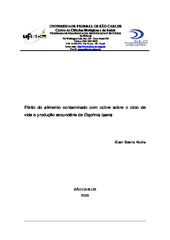Efeito do alimento contaminado com cobre sobre o ciclo de vida e produção secundária de Daphnia laevis
Abstract
With the advance of industrialization, there was an increase in the quantity of substances discharged in nature without treatment. Many of these substances are toxic and can cause adverse effects to aquatic biota, and may affect the rest of the food chain, including humans. For better understanding of the effects of contamination, there is a growing progress in the study of exposure of organisms of different trophic levels of the contaminant and monitoring changes in their development and reproduction. Copper, an
essential element at low concentrations, can cause adverse effects in higher concentrations. The aim of this study was to evaluate changes in a zooplankton species, Daphnia laevis (Crustacea, Cladocera) fed with algae (Pseudokirchneriella subcapitata) previously exposed to different concentrations
of copper. The accumulation of metal was measured both in algae and in cladoceran. The animals were monitored throughout its life cycle through the testing of chronic toxicity and through bionomic parameters and calculation of
their secondary production, the treatments were compared to a control. The results suggest that exposure to contaminated food directly influence the reproduction of animals, and found significant statistical differences (p <0.05) in the total number of eggs and neonates produced over the life of the animal.
Another parameter that was affected significantly was the secondary production of animals, where changes were observed mainly in the investment to reproduction, affecting the total secondary production. Through the results, consider the importance of the capture of copper through the food and how the secondary production, although very important, is not explored in ecotoxicological studies.
